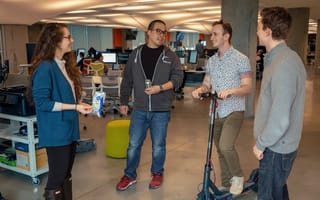
Chicago systems engineers may share similar titles, but what they do day to day can be very different.
At Enduvo, systems engineers could be optimizing a virtual reality platform for mobile headsets, whereas at Jellyvision or tastytrade, system engineers could be streamlining the communication layer between legacy systems or spending their days updating Elasticsearch, respectively.
But, no matter the project or platform, some traits are ubiquitous for success in the role, according to three technical pros we spoke to from these companies. They include: understanding the full scope of how various systems fit into core business functions; creating a shared vocabulary to reduce ambiguity in naming conventions; and being an effective problem-solver to make quick and creative decisions.
Without these traits, the engineers — who have more than 20 years of experience between them — said systems and their impacts on a business could grow convoluted. Systems could get bogged down with confusing terminology and unnecessary processes that slow production and negatively affect users.
These engineers said they use the above skills to not only keep their systems operating efficiently but work on exciting projects every day that help advance their skills.
Nathan Green, a software engineer II at Jellyvision, said managing ambiguity is a key part of seeing success as a systems engineer. So his team at the employee benefits platform has a shared glossary they use to stay aligned on vocabulary and reduce ambiguity.
A typical day as a systems engineer at Jellyvision: “As a software engineer on an agile team, day-to-day tasks mostly revolve around the work currently slotted into our sprint,” Green said. “However, we have several initiatives rolling right now, so there’s quite a bit of planning to do. Beyond working on features and bug fixes, the job also involves communicating with stakeholders, keeping projects organized and documented and sharing knowledge with the team. Additionally, we strive to get code reviewed within 24 hours of it hitting our inbox, so code reviews are typically a daily task.”
Hold the line with your system vocabulary as best you can.”
A project Green is excited about: “Lately, we’ve been working on streamlining the communication layer between a couple of legacy systems and it’s a pretty big paradigm shift for us. Part of this initiative came from a team we spun up called the ‘Systems Integration Team’ whose mission was to identify high-level cross-system opportunities to improve architectures.
“We’re moving from a queuing system that generates static assets consumed by an API to more of an event-driven pattern that updates a database. This change is going to save hundreds of hours for our users who release thousands of updates to our interactive conversations over the course of the year. We’re strategically addressing technical debt in a way that will deliver real value. It also feels really good to bring some love to these legacy systems.”
Skills a systems engineer needs: “One important skill to have as an engineer working across multiple systems is the ability to manage ambiguity. Systems tend to take on a life of their own and organizational processes can evolve faster than the system’s ability to react. If not managed, you can end up with things suddenly being named strangely or have different layers of abstraction that make it difficult to determine how a system works.
“The old adage ‘naming things is hard’ plays out all the time. How do you manage that problem over time? One strategy we’ve seen some success with is merely defining a glossary that we can point to as a source of truth about what processes are called and what they mean. What are the nouns and verbs of the systems in question? Who are the users and their actions? Keep a running dialog with your stakeholders and hold the line with your system vocabulary as best you can.”
Infrastructure Engineer JT Schelling said he’s been enjoying evolving Elasticsearch within the financial services company tastytrade. The project has given him greater breadth of experience in his day-to-day work and is helping him grow his skill set, he said.
A typical day as a systems engineer at tastytrade: “I usually start my day by checking our monitoring software for anything actionable that came up overnight or over the weekend,” Schelling said. “I deal with any immediate or easy issues and make notes, then backlog any other non-immediate matters. I spend the rest of my morning focused on larger projects like writing new Chef code or researching solutions to long-term problems. After that, I might stage deployments or contact teammates to work through pair issues with them. I do most of my code reviews in the afternoon and end the day with production deployments.”
Identify how all the disparate systems in a production environment fit into the larger puzzle.”
A project Schelling is excited about: “I’m currently working on upgrading our Elasticsearch deployment to deal with performance scaling long-term work. This project is full of interesting work like interacting with third-party support teams and hardware benchmarking, which I don't get to do in my average day to day.
“It’s been fun learning more about the internals of a tool our team uses every day. I’m getting exposure to other parts of systems engineering through the hardware-buying process and reformatting the deployment architecture to allow for long-term scalability. I really enjoy getting larger projects that allow me to grow as an engineer and develop a true depth of knowledge with individual tools.”
Skills a systems engineer needs: “First, it’s vital to be able to identify how all the disparate systems in a production environment fit into the larger puzzle of a functioning and reliable platform. Second, always be working to better understand the core business functions and requirements of the company. Understanding the interactions between these separate pieces helps a system engineer understand where potential problems can arise and makes them better and faster at resolving production issues.”
Lead Engineer Justin Drawz and his team at augmented and virtual reality content provider Enduvo said they’ve been busy working with the Oculus Quest hardware. Drawz said the project has been fun but challenging because of the restrictions placed on the team by the hardware and the pandemic.
A typical day as a systems engineer at Enduvo: “I start my morning by reviewing our dev team’s progress and planning out goals for the day,” Drawz said. “From there, I check application diagnostics and follow up on any technical support requests. Next is our team’s daily stand-up to discuss status, roadblocks and next steps. Based on this discussion, I schedule time to collaborate with team members, assist with design, help with system integrations and do code reviews.
“Later in the day, I work with our business and product teams on the product roadmap. This collaboration may involve many things: assessing upcoming technology choices, reviewing high-level system design or working with a product owner to define smaller, solvable pieces. With my remaining time, I dive into my own development items like larger system implementations, integrations or pipeline improvements. I conclude by summarizing out my results and checking in on the team’s progress again.”
A successful engineer can break down a complex problem into more manageable components.”
A project Drawz is excited about: “I’ve really enjoyed bringing the Enduvo application to the Oculus Quest. There’s immense value in virtual reality, but many VR headsets require a high-end gaming computer to run them. The Quest delivers those benefits of immersion but in an affordable mobile device.
“For this project, the engineering team and I focused on reducing the memory footprint of the application. We also began implementing systems to ensure users’ digital assets were compatible across platforms. This move was particularly challenging when considering complex 3D models designed for use on a PC. Despite the physical distance caused by the pandemic, we optimized the platform for mobile hardware and redesigned the workflow for authoring immersive experiences on these devices.”
Skills a systems engineer needs: “Engineering is all about problem-solving. A successful engineer can break down a complex problem into more manageable components, identify the important details and use this understanding to formulate a creative solution. This ability not only results in improved efficiency and higher-quality code from the individual but also provides a framework for better communication across the team. With a problem modeled in this way, it’s much easier to focus on the details and it takes far less effort to make decisions.”













